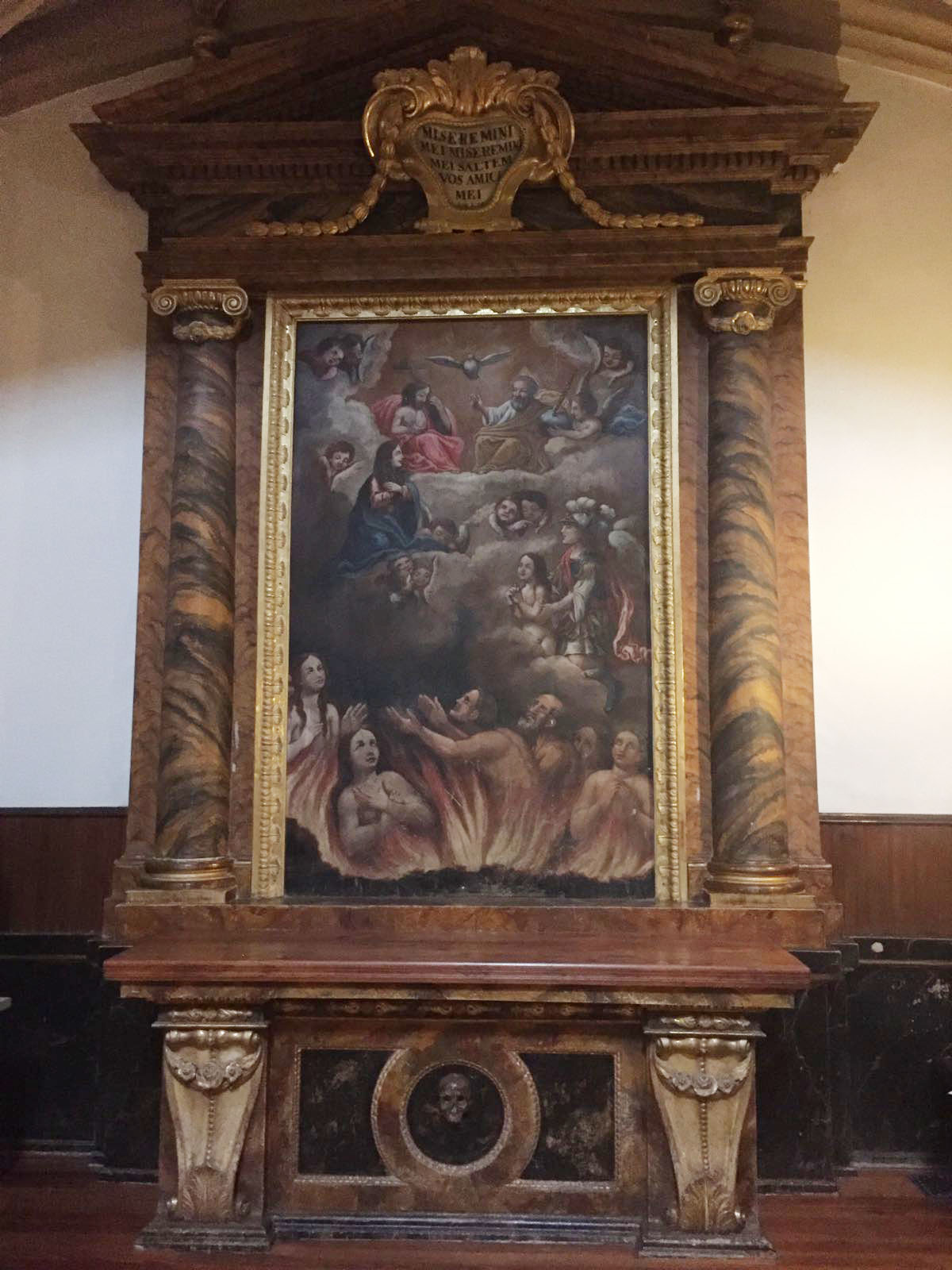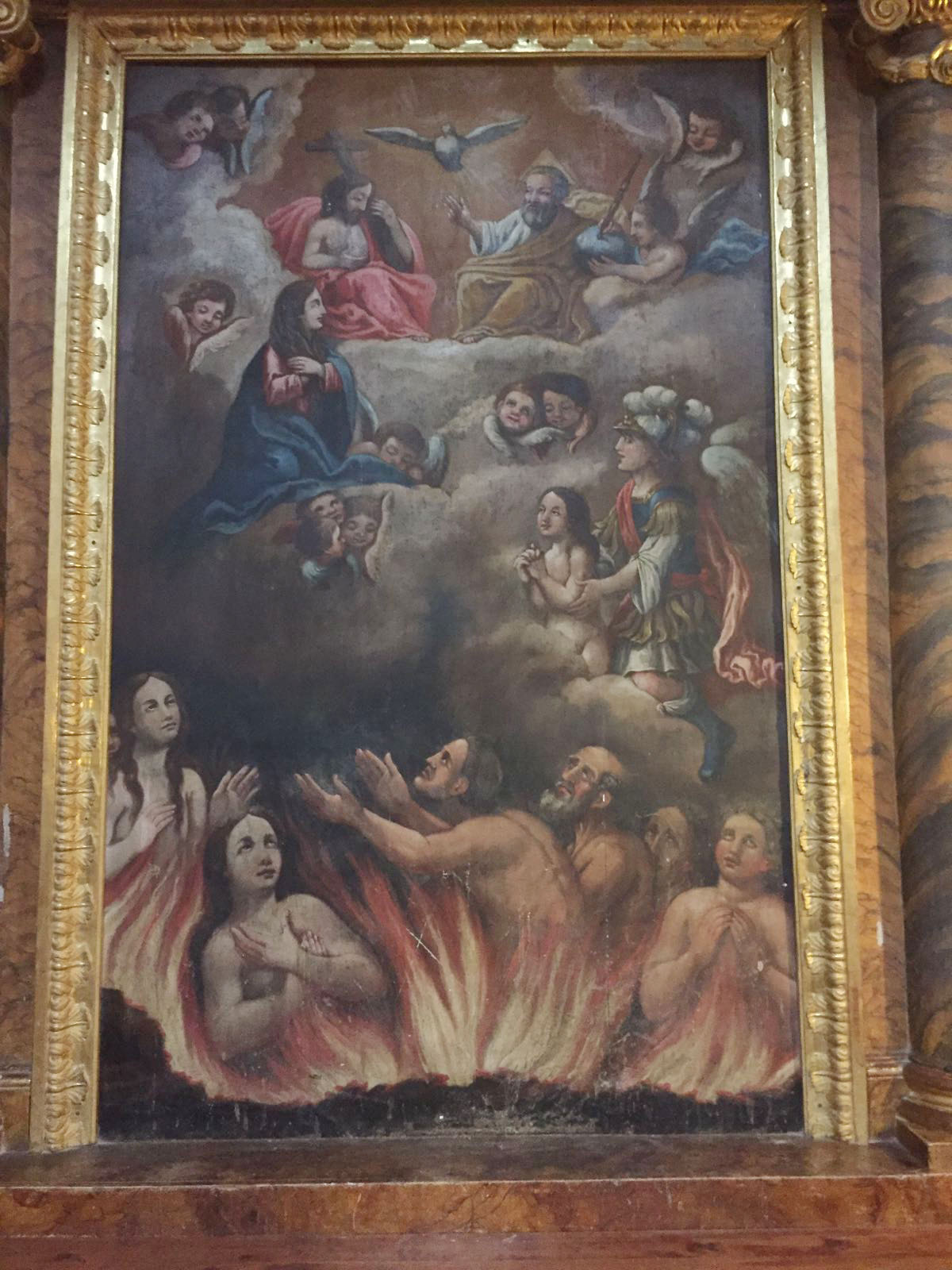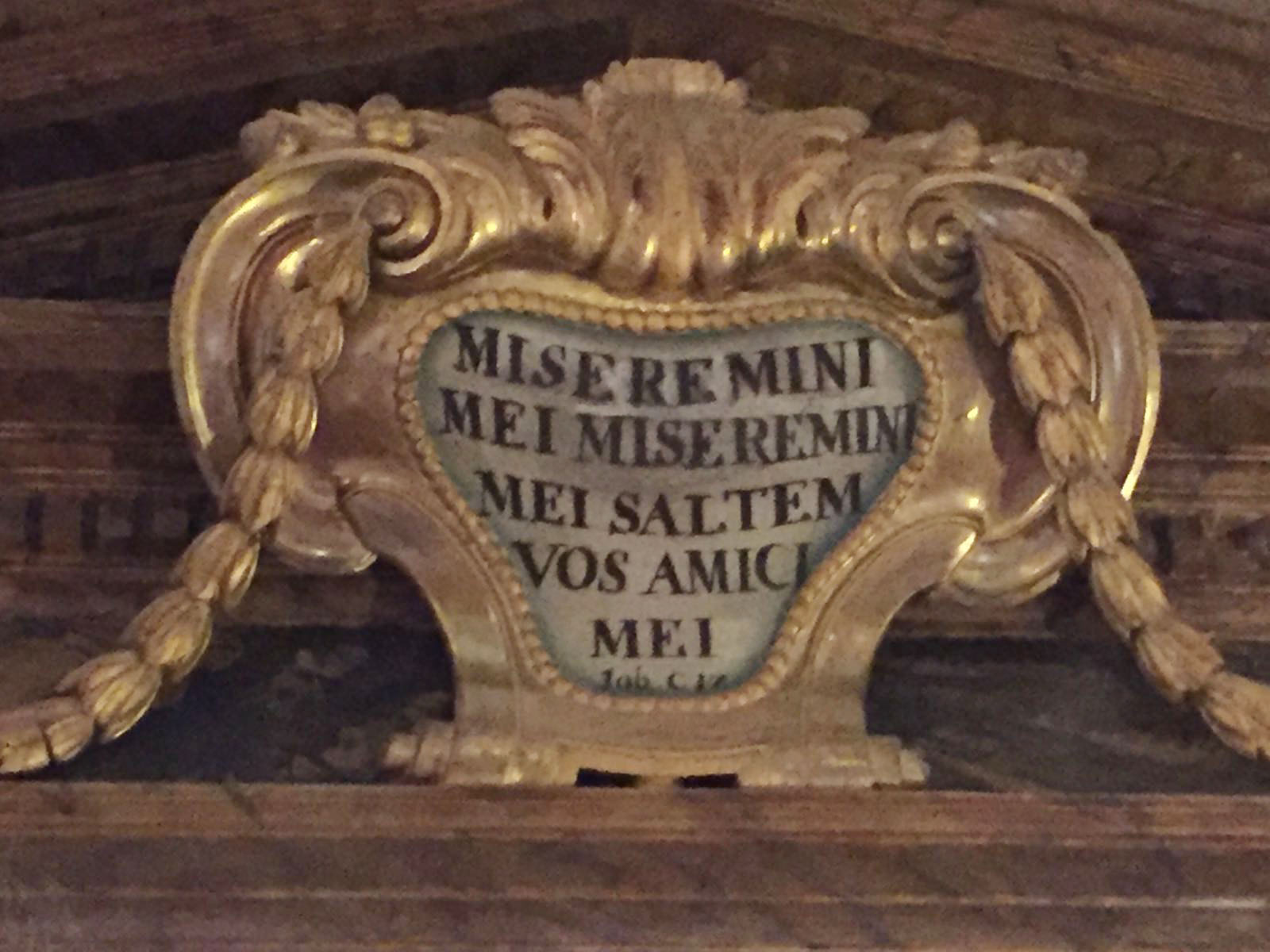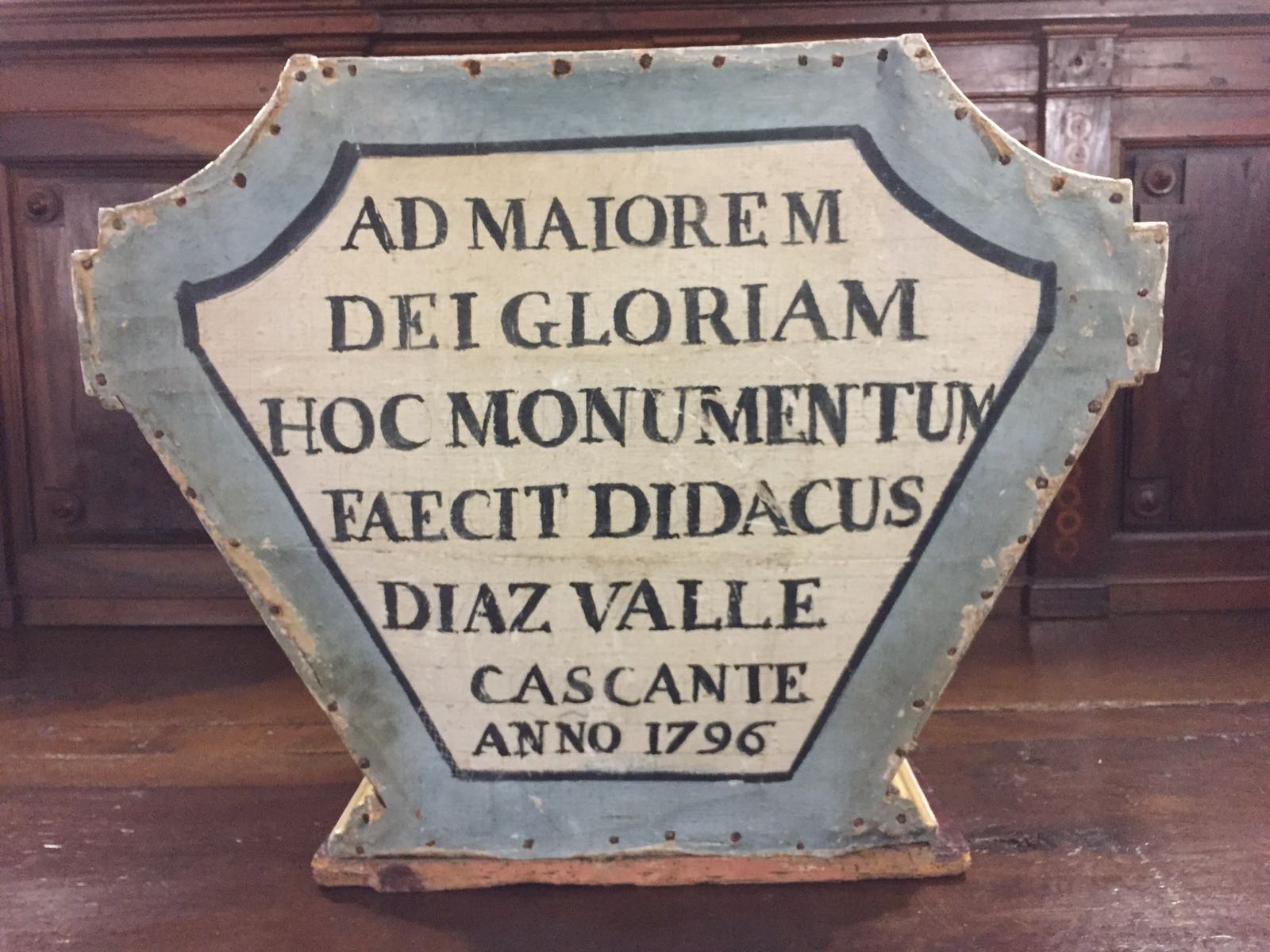The piece of the month of November 2016
THE PAINTING OF THE SOULS IN PURGATORY IN THE PARISH OF SESMA, THE WORK OF DIEGO DÍAZ DEL VALLE
Iñigo Serrano Sagaseta de Ilúrdoz
graduate in Ecclesiastical History and programs of study
Within the group of side altarpieces that were made in the parish church of Sesma during the 18th century, on the Epistle side and below the organ rostrum, there is one dedicated to the Souls in Purgatory, which houses a large altar painting signed by Diego Díaz del Valle (1740-1817).

The dedication of an altar to the Ánimas is common in parishes, where masses and novenas are offered in suffrage for the deceased. It is one of the devotions that gained momentum in the Counter-Reformation as a reaction to Luther's doctrine denying the reality of purgatory.
Purgatory - from the Latin Purgatorius, which purifies - is the state of temporary expiation of venial sins. Thus, the souls of the faithful who die in repentance, without having done penance, or before doing penance, attain complete purification and the glory of eternal life. The Council of Trent ratified the dogma of purgatory in its XXV session, in which it is stated "that there is a purgatory and that the souls who are retained in it are helped by the suffrages of the faithful and principally by the holy sacrifice of the altar".
After this decree, at the end of the 16th century, purgatory began to be represented in Christian art. In Rome, in the chapel of the Angels of the Gesù, we find one of the earliest representations. Federico Zuccaro's fresco places a burning bonfire before our eyes and the angels, immersed in this sea of fire, draw from it small figures representing the souls and offer them to Christ and to the Virgin, seated beside him in heaven.
Sesma's painting (1796) also shows the souls amidst the flames of purgatory in the lower part. Men and women of different ages can be distinguished among them. On a cloud raised above purgatory is the beautiful and graceful figure of Saint Michael the Archangel, perfectly identifiable, with his helmet and breastplate. This is an iconography known as Saint Michael psychopompus, i.e. conductor of souls. The archangel appears with a soul in his arms, which he has taken out of purgatory and lifts it up through the clouds to the Holy Trinity who is waiting for it high in heaven. This function of the Archangel Michael is not explicitly mentioned in the Sacred Scripture, but it has been traditionally handed down in the history of the Church. Popular religiosity also includes it in various verses in honour of the Archangel: "Who is like God? No one like God. St. Michael the Archangel, great battler, presents souls to the tribunal of God".

On a higher level, among clouds and angels, is the Virgin Mary, the main intercessor between God and mankind, who, dressed in a blue mantle, looks to her Son to plead for the souls in purgatory, so that he may "free them from sorrow and bring them to rest". Finally, in the highest part is the Holy Trinity, God the Father, painted as an old man with the ball of the world and to his right God the Son carrying the cross through which he redeems the souls. Between the two, the Holy Spirit in the form of a dove tops the whole ensemble.
Above the large altar painting, there is an elegant neoclassical-style cartouche, registration , which reads as follows: Miserere mini mei, miserere mini mei, saltem vos amici. These words from the Book of Job are an appeal to all those who pass in front of this altar to offer prayers in suffrage for the deceased. Similarly, the skull sculpted on the front of the altar is a reminder of the fleetingness of this life and the vanity of the world, inviting us to aspire to eternal goods.

The Sesma painting is of average quality, as are all the works by the artist Díaz del Valle scattered throughout the province of Castile and the neighbouring provinces. However, his iconography is interesting and is undoubtedly a reflection of the Cascantino painter's handling of both graphic and literary sources. Thanks to some of the writings he left us and which were published after his death, we know that he had read Vitruvius, Carducho and Alberti, among others. He was also familiar with the Iconology of Caesare Ripa.
In addition to the commissions he received from religious institutions such as the Franciscans of Olite, the collegiate church of Borja, the basilica of La Purísima in Cintruénigo, the Carmelites of Araceli in Corella and the parish church of his native Cascante, among many others, Diego Díaz del Valle also received commissions from the civil sphere, specialising in portrait galleries.
He painted the gallery of portraits of the kings of Navarre for Pamplona City Hall, as well as some isolated portraits for the regiment of Tudela. He also painted seven canvases for Tudela cathedral depicting various benefactors of the cathedral who contributed to raising its status from collegiate church to cathedral, and in Sada a portrait of Bishop Úriz y Lasaga, a native of that town, which was published by Goñi Gaztambide in his Historia de los obispos de Pamplona ("History of the Bishops of Pamplona"), is in a private collection. On the other hand, the portrait gallery commissioned by the Marquis of San Adrián has not been preserved.
The portraits he painted are not really outstanding for their quality. Fernández Gracia states that the reason he received such commissions is undoubtedly to be found in the fact that he was the only easel painter based in Navarre during the last third of the 18th century.
Returning to Sesma, the painting of the Souls in Purgatory was not the only work he did for that parish. He was also in charge of the Holy Thursday Monument. A work of ephemeral architecture with great perspective, of which the tabernacle is preserved on the back of which clearly reads: AD MAIOREM DEI GLORIAM HOC MONUMENTUM FAECIT DIDACUS DIAZ VALLE CASCANTE ANNO 1796. We have to take into account that by this date he had already made other monuments such as the one in Cintruénigo (1768), the one in Cascante (1782) and the one in the cathedral of Tudela, which would serve as model of the previous one. The parish of Sesma thus adds two new works to the enormous Catalog of the artist from Cascante.

bibliography:
FERNÁNDEZ GRACIA, R., "Diego Díaz el Valle: un pintor de Cascante en el Siglo de las Luces", in Chair de Patrimonio y Arte navarro. report 2013, Pamplona, Chair de Patrimonio y Arte navarro, 2014, pp. 170-173.
MALE, E., El Barroco. Arte religioso del siglo XVII, Madrid, meeting, 1985, pp 84-87.
